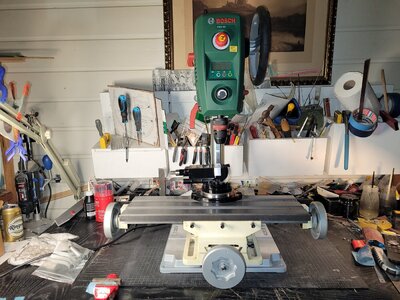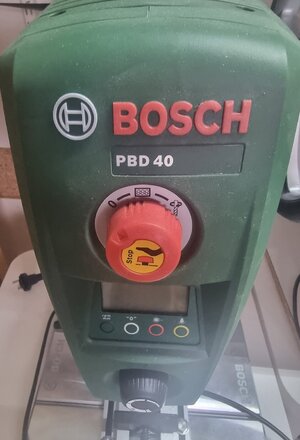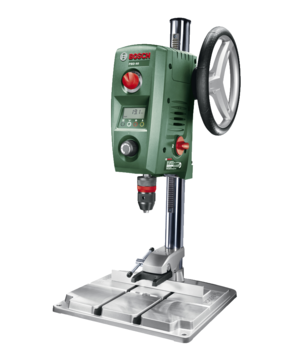-

Win a Free Custom Engraved Brass Coin!!!
As a way to introduce our brass coins to the community, we will raffle off a free coin during the month of August. Follow link ABOVE for instructions for entering.
You are using an out of date browser. It may not display this or other websites correctly.
You should upgrade or use an alternative browser.
You should upgrade or use an alternative browser.
Just found this photo published by our member @Norway in his log
The same drill with table(s)

The same drill with table(s)
NORWAY`S HMS BLANDFORD CROSS SECTION BUILD 1-32
Nice little progress, Knut. I like your dead eyes, they look great.
shipsofscale.com

A bench drill designed for up & down movement, it does not have suitable bearings for milling - sideways movement.
- Joined
- Dec 3, 2018
- Messages
- 2,451
- Points
- 538

@Stuart Little , from what I've heard there are several other modelers using this machine for that,
I also don't think that the load will be very large since I will only be using it for relatively small pieces of wood,
Thanks for the warning, I'm not going to mill sideways on metal.
Thank you, regards Knut-
I also don't think that the load will be very large since I will only be using it for relatively small pieces of wood,
Thanks for the warning, I'm not going to mill sideways on metal.
Thank you, regards Knut-
I also have a very similar drill from a different manufacturer. I am wondering if the drill chuck in such a drill can be tightened sufficiently to prevent the mill cutter from wandering downwards during the milling operation. I guess it should be sufficient when removing small amounts of material in one milling operation.
Trevor.
Trevor.
Impressive video. With that in mind, milling small wooden details should be no problem.Cut the address and paste it into the search field on You Tube, I couldn't make the link, impressive video,
This tells me that it is possible to use coordinate tables together on this machine, Knut-
How does the drill chuck mount? Morse taper? If so, quality drill chucks can be purchased ie Jacobs. And as far wobble in the drill press quill is concerned, itmay be improved by replacing the bearings with quality sealed bearings available in the aftermarket. Working on models and the materials they have is no big load or issue with these machine tools.I hope this drill chuck tightens well enough, if not I'm considering switching to a keyed drill chuck.
As you say, the most important thing is to remove small amounts of material in each operation.
Some chucks mount via a morse taper tang into the quill, while others are removed by opening the jaws and removing a screw internally....and the are some OLD designs that actually are threaded. There are a lot of youtube videos on removing a drill press ( and even hand drills) chucks.....After I watched the video above, there was an advertisement for a video on changing the drill chuck, it looked like it wasn't that difficult.
Wondering if the man from China has changed the bearings and the drill chuck. hmm
Last edited:
- Joined
- Aug 8, 2019
- Messages
- 5,484
- Points
- 738

Your guaranty will be lost when you change the bearing. That's why I bring back my machine to the shop and changed it for a second hand drill press and a new bandsaw of scheppach. Wobbling of the head was for me a problem, I use it for my hobby only and then it has to be precise.
I think @Tobias have the scheppach drill press. Almost the same machine in looks. Wonder if the wobbling is in that machine.
I think @Tobias have the scheppach drill press. Almost the same machine in looks. Wonder if the wobbling is in that machine.
Can you use a dial indicator to measure the run-out? Measuring the chuck and measuring the quill? If it wobbles, where is the errant motion coming from?It would have been interesting to hear what is said about the Scheppach drill press, it is not, Hobbling with the head, on my machine when it is stopped.
I will try with a thick drill and different speeds, then I can tell more.
Last edited:
- Joined
- Aug 8, 2019
- Messages
- 5,484
- Points
- 738

You can measure with a sharp penicilline. Put the penicilline in the drill with the drawing point down. Let the drill down to a sheet of paper on a plate and move the head of the drill. On the paper you can see the movement. Measure that and the lenght of the penicilline from the head to the paper and you have your wobbling factor.
The wobbling comes from the needle bearings. 2 ball bearings instead would be much better.
The wobbling comes from the needle bearings. 2 ball bearings instead would be much better.





